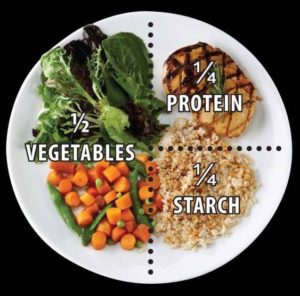Change the look of your plate

An effective way to reduce our food calorific intake is to reduce fats in our diet.
Life style change starts with small steps. The standard American diet is one rich in red meat, dairy products, processed and artificially processed sweetened foods, fats and salt..
It is time to turn this around and make the change to a diet high in vegetables, fruit, lower fat content protein sources like fish and chicken, and to introduce more whole grains. We do not need to add extra oil or fat to our diet. Most diets have sufficient fat without having to add extra. Fat is contained in dairy, chicken, fish, nuts and vegetables like avocados.
Last week we encouraged the move from a full- size dinner plate to a smaller 9” salad plate size. This helps put smaller portions on your plate and to reduce food intake.
The next step is to look at your plate and make small changes to what is on it.
Divide your plate into 4 quarters. 2 quarters or a half of it should be filled with vegetables. Quick, convenient and simple – use frozen vegetables that just need reheating or chopped salad that you have already prepared in advance. Use fresh cut vegetable sticks like carrot, celery and peppers. This leaves ½ the plate for protein and carbs combined.
Reducing or eliminating extra added fats, like mayonnaise, hard cheese, oil dressings, cooking oil, fried foods like French fries and battered products is one of the first steps to make to help put us on our weight loss reduction curve.
We also need to look closely at our protein sources. Trim off skin and extra fat from meats before cooking. If you can, substitute fish for meat or a vegetarian option a few nights a week.
A healthier diet is one containing less processed foods and more
- whole grains
- vegetables and fruits
- lean white meat and fish
- limits the use of oils, choose liquid oils from vegetable sources.
If you use fats, use and choose Good Fats over Bad. What we mean by that is choose fats that are liquid at room temperature and are mainly of vegetable origin.
Example: Olive oil, canola oil, sunflower oil, peanut oil, sesame oil, rape seed oil, fish oil, nut oils (walnut oil, almond oil), corn oil, soybean oil, safflower oil.
Avoid or limit use of hard fats, like Crisco, butter, hard margarine, processed meats, lard, fast food, and any processed food that lists Trans Fats and Saturated Fats as a percentage of the fat content in the nutrition facts panel.
Here are some simple pre-emptive actions that you can make into good life change habits in the kitchen.
- Check your pantry for bad fats, change your buying habits and move to oils made from vegetable sources.
- Choose fresh foods over processed foods
- Measure your portions of nuts –e.g. ½ oz. of peanuts has 120 calories
- Use a non–stick pan spray or oil atomiser spray.
- Measure the portion of added oil – instead of splashing from the bottle
- Trim fat and skin from meat before cooking
- Grill or broil rather than fry or deep fry
- Choose fish or lean chicken without skin over red meats
- Control portion size of cheese, margarine, milk, salad dressings, processed luncheon meats.
- Limit salad dressings, substitute with balsamic vinegar or lemon juice and fresh herbs.
Being aware of what you are eating and look for opportunities to lower fat content is a quick and effective way to get started on a weight reduction program.
For most people a simple reduction of 200 calories a day can make the difference between slow gradual weight loss and no weight loss at all.
1 gram of fat has double the calorific content as 1 gram of protein or 1 gram of carbs.
Cutting back on fats makes sense.
The Action:
- Change the look of your plate
- Review your daily menu and eliminate foods high in fats.
Share your ideas and successes in the Mission Thin Possible members area to inspire other team members.


Comments ( 0 )